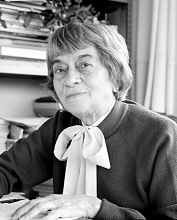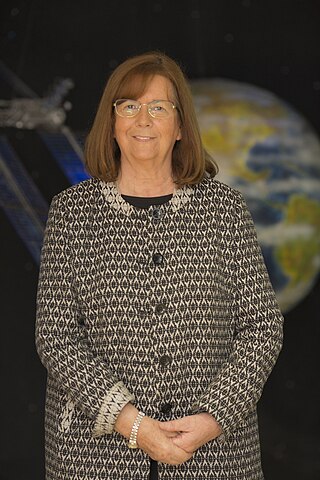Related Research Articles

Sandra Moore Faber is an American astrophysicist known for her research on the evolution of galaxies. She is the University Professor of Astronomy and Astrophysics at the University of California, Santa Cruz, and works at the Lick Observatory. She has made discoveries linking the brightness of galaxies to the speed of stars within them and was the co-discoverer of the Faber–Jackson relation. Faber was also instrumental in designing the Keck telescopes in Hawaii.
Donald Edward Osterbrock was an American astronomer, best known for his work on star formation and on the history of astronomy.

Guillermo Haro Barraza was a Mexican astronomer. Through his own astronomical research and the formation of new institutions, Haro was influential in the development of modern observational astronomy in Mexico. Internationally, he is best known for his contribution to the discovery of Herbig–Haro objects.

Marie Paris Pişmiş de Recillas was an Armenian-Mexican astronomer.
Jerry Earl Nelson was an American astronomer known for his pioneering work designing segmented mirror telescopes, which led to him sharing the 2010 Kavli Prize for Astrophysics.

Tonantzintla Observatory is an astronomical observatory located in the municipality of San Andrés Cholula in the Mexican state of Puebla. It consists of two adjacent facilities: the National Astrophysical Observatory of Tonantzintla, operated by the National Institute of Astrophysics, Optics and Electronics (INAOE), and the National Astronomical Observatory - Tonantzintla, operated by the National Autonomous University of Mexico (UNAM). OANTON is located on the INAOE campus, which includes numerous other buildings. OAN - Tonantzintla is located immediately to the east on mostly unused property. The observatory is located 11 kilometres (6.8 mi) west of Puebla and 33 kilometres (21 mi) east of Popocatépetl, eruptions of which sometimes interfere with observing.
Guido Münch Paniagua was a Mexican astronomer and astrophysicist.

María Teresa Ruiz is a Chilean astronomer who was the first woman to receive Chile's National Prize for Exact Sciences, the first female recipient of a doctorate in astrophysics at Princeton University, and the first woman president of the Chilean Academy of Sciences. She is known, too, for the discovery of the brown dwarf Kelu-1.
The Revista Mexicana de Astronomía y Astrofísica is a peer-reviewed scientific journal of astronomy founded in 1974. It is a successor to the Boletín de los Observatorios de Tonantzintla y Tacubaya which was published from 1952 to 1972.

Estela Susana Lizano Soberón is a Mexican astrophysicist and researcher. She has specialized in the theoretical study of star formation.

Antígona Segura Peralta is a Mexican physicist and astrobiologist. Since 2006, she has been a researcher at the Institute of Nuclear Sciences of the National Autonomous University of Mexico (UNAM) and collaborator at the NASA Astrobiology Institute. As a feminist she actively advocates for the inclusion of women in the exact sciences, mathematics, and engineering. Segura has participated in several activities in and outside UNAM defending women's rights; she was awarded with the 2021 Hermila Galindo medal by the Congress of Mexico City.
María Magdalena González Sánchez is a Mexican astrophysicist, nuclear physicist, researcher, and professor best known for her contributions in gamma ray research and for being the head of the High Altitude Water Cherenkov Experiment (HAWC). She has published 90 articles about her field of study in indexed journals. In 2015 she received the Sor Juana Inés de la Cruz Recognition from the National Autonomous University of Mexico (UNAM).
Déborah Oliveros Braniff is a Mexican mathematician whose research interests include discrete geometry, combinatorics, and convex geometry, including the geometry of bodies of constant width and related topics.
Martha Yoko Takane Imay is a Mexican mathematician whose research topics include linear algebra, representation theory, and algebraic combinatorics. She is a professor at the National Autonomous University of Mexico (UNAM) and a researcher in the UNAM Institute of Mathematics.
Maritza Arlene Lara-López is a Mexican astronomer whose research interests include metallicity in galaxy formation and evolution and extragalactic astronomy. She is a participant in the Galaxy And Mass Assembly survey, and a researcher and Ramon y Cajal Fellow in the faculty of physical sciences at the Complutense University of Madrid.
Christine Patricia Allen Armiño is a Mexican astronomer whose research has included runaway stars including the Becklin–Neugebauer Object, the overall distribution of mass in the Milky Way and its effects on stellar orbits, binary and multiple star systems, and the applications of binary star observations in testing physical theories. She is a senior researcher at the Institute of Astronomy of the National Autonomous University of Mexico, and the editor of the Mexican Magazine of Astronomy and Astrophysics.
Erika María Benítez Lizaola is a Mexican astronomer whose research involves blazars and active galactic nuclei. She is a professor in the Faculty of Sciences at the National Autonomous University of Mexico (UNAM) and a researcher in the UNAM Institute of Astronomy.
Silvia Susana Bravo Núñez (1945–2000) was a Mexican astronomer specializing in solar physics including the study of the Sun's corona, solar wind, and the Sun's magnetic field. She was one of the pioneering researchers in the department of space sciences of the National Autonomous University of Mexico (UNAM) Institute of Geophysics.
María Leticia Carigi Delgado is a Venezuelan astronomer specializing in cosmochemistry, including the overall metallicity of galaxies and galactic halos, and the evolution of galaxies. She works in Mexico as a researcher and professor in the Institute of Astronomy of the National Autonomous University of Mexico (UNAM).
Irene Cruz-González Espinosa is a Mexican astronomer whose research interests include the observation of galaxies and the extragalactic medium, star formation, and optical and infrared telescope instrumentation. She is a researcher and professor in the Institute of Astronomy at the National Autonomous University of Mexico (UNAM).
References
- 1 2 "Dra. Elsa Recillas Pishmish", Directory of researchers, National Institute of Astrophysics, Optics and Electronics, retrieved 2022-12-12
- ↑ Poniatowska, Elena (1999), "La doctora en astronomía Paris Pishmish", La Jornada
- ↑ Astronomy section members (PDF), Mexican Academy of Sciences, 2022, retrieved 2022-12-12